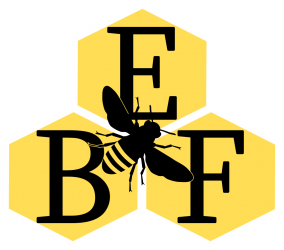We were ready. The hives were assembled and painted, the foundations were on the frames, the bottom boards, top screens, and roofs were handmade to (almost) perfection. We even made our own entrance reducers. It all looked serene sitting in the garage waiting for tens of thousands of buzzing inhabitants. The only thing we needed yet was the feeder. That didn’t seem like a problem. A dish with some sugar water, right? Apparently there are as many plans for feeders as there are opinions on which feeder is the best.
| What I thought would happen |
A feeder touted as “no-drown” seemed the way to go. That narrows it down by 5%. After some careful thought and deliberation – and a little too much time in beekeeping forums – a screened ladder looked like a good way to go. The principle is quite simple. Bees fly up into the feeder through a small opening in the bottom, walk down a ladder made of hardware mesh, take a drink, and walk out. Perfect. The design looked simple enough to make. No problem. Besides, I thought this through, and if there was a glaring design problem, I’m sure Andy would point it out. The problem is that I’m a scientist, not engineer, and I took it upon myself to come up with the final design. The box was simple, just a medium super with a plywood bottom and a 4″x2″ inch opening at the one end for the bees to travel up. The opening was flanked by some 3 1/4″ high wood to enclose it. On the other side we added a 10″x10″ aluminum pan for the sugar syrup. Done. For the ladder we simply cut a piece of #8 hardware cloth and stapled it in place. There, the bees can eat. We didn’t want bees flying around in the feeder, so the ladder was stapled on the top of the opening then leading down into the syrup. We effectively made a nice roof to protect our bees from flying around the feeder. We wouldn’t want them to accidentally land in the syrup and drown. There was no mesh bottom for the bees to walk down, but that wasn’t a problem, I reasoned. The bees would fly up to the opening, make a short jump to the mesh roof and crawl upside down to the sugar syrup, and return the way they came. They’re smart, right? As I’m writing this, I cringe at how stupid my logic was. Really? The bees will just crawl upside down to eat? What was I thinking?
|
|
| What did happen |
Nonetheless, the feeder went onto our newly installed packages. We were so careful during the installation. Everything was perfect. Only a few squished bees. Nothing to worry about, we’ve got plenty. The next day I peaked in to see if the bees were eating. It seemed odd there were a dozen or so dead bees floating in the pan. No matter, they’ll figure out how to eat. I’m sure there’s some worker doing her waggle dance telling the rest they need to suspend upside down to eat. But alas, there is not. The following day I returned to find a even more drowned bees. I witnessed the atrocities. The bees were just flying up to the opening and taking a step off into the abyss of sugar syrup. Trying their best to fly out, their flight to safety was impeded by the cleverly built upside down ladder, forcing them to plunge back into the syrup, sealing their fate. I had build a bee death trap.
| The fix |
Quickly I called Andy who realized the error of my plans. He immediately went to work on making and installing a proper ladder that is fully enclosed, complete with a mesh bottom. The next day I once again peaked in. There they were, walking down the ladder, drinking up till their hearts’ content. The bees seem quite happy no one is trying to kill them.

